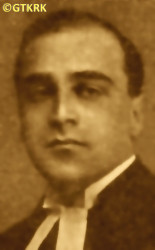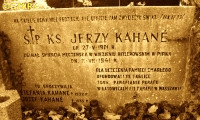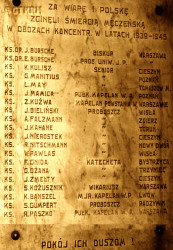Roman Catholic
St Sigismund parish
05-507 Słomczyn
85 Wiślana Str.
Konstancin deanery
Warsaw archdiocese, Poland
full list:
displayClick to display full list

searchClick to search full list by categories
wyświetlKliknij by wyświetlić pełną listę po polsku

szukajKliknij by przeszukać listę wg kategorii po polsku

Martyrology of the clergy — Poland
XX century (1914 – 1989)
personal data
surname
KAHANE
forename(s)
George (pl. Jerzy)
function
pastor
creed
Evangelical Church of the Augsburg Confession in Poland EA
diocese / province
Greeter Poland seniority (commissariat)more on
pl.wikipedia.org
[access: 2019.04.16]
Cieszyn seniority (commissariat) / diocesemore on
en.wikipedia.org
[access: 2016.04.23]
Evangelical Military Pastoral Caremore on
pl.wikipedia.org
[access: 2024.12.13]
nationality
German
date and place
of death
09.07.1941

TA SonnensteinSchloss Sonnenstein „euthanasia” center
today: Pirna, Sächsische Schweiz‐Osterzgebirge dist., Saxony state, Germany
more on
en.wikipedia.org
[access: 2022.07.18]
alt. dates and places
of death
11.07.1941
details of death
During Polish–Russian war of 1919‐1921 volunteer of the Polish Army — served in 21st „Children of Warsaw” Infantry Regiment (or in the 201st Infantry Regiment; there are also indications that was declared unfit for military service).
After German and Russian invasion of Poland in 09.1939 and start of the World War II, after start of German occupation, deported in 11.1939 from Pomerania (according to other sources went into hiding).
Moved to Warsaw (prob. in 08.1940), then already in German‐run General Governorate.
In 02.1940 arrested by the Germans and transported to KL Stutthof concentration camp.
There beaten — had spine damaged.
Next transported to KL Sachsenhausen concentration camp.
Finally, after four months in a barrack used as camps' „hospital” (at least in 14.02.1941‐05.05.1941), in a group of „invalids”, taken on 07.06.1941 to Pirna‐Sonnenstein castle, to the so‐called German Euthanasia Institute.
There became a victim of barbaric „medical experiments”, and next murdered in the gas chamber (part of genocidal German «Aktion T4» plan, under a codename Aktion 14f13) — in the register of KL Sachsenhausen, the cause of death was recorded as „circulatory disease”.
prisoner camp's numbers
36002 (KL SachsenhausenClick to display the description)
cause of death
extermination: gassing in a gas chamber
perpetrators
Germans
sites and events
TA SonnensteinClick to display the description, «Aktion T4»Click to display the description, Medical experimentsClick to display the description, KL SachsenhausenClick to display the description, KL StutthofClick to display the description, «Intelligenzaktion»Click to display the description, Ribbentrop‐MolotovClick to display the description, Polish‐Russian war of 1919‐1921Click to display the description
date and place
of birth
27.05.1901

Warsawtoday: Warsaw city pov., Masovia voiv., Poland
more on
en.wikipedia.org
[access: 2021.10.09]
presbyter (holy orders)
ordination
28.01.1928

positions held
1937 – 1939
parish priest — Gdyniatoday: Gdynia city pov., Pomerania voiv., Poland
more on
en.wikipedia.org
[access: 2021.09.02] ⋄ EA parish — also: administrator of the congregations in Tczew and Starogard Gdański; co‐founder of the Fr Christopher Celestine Mrongovius's Association of Evangelical Poles na in the Free City of Danzig (1938); editor of „Evangelical Review”
1933 – 1937
prefect — Katowicetoday: Katowice city pov., Silesia voiv., Poland
more on
en.wikipedia.org
[access: 2021.08.12] ⋄ Our Lord's Resurrection EA parish — i.a. teacher of a gymnasium in Chorzów; also: editor of „Upper Silesian Evangelical”,, collaborator of the Association of Evangelical Poles
1931 – 1933
auxiliary chaplain — Warsawtoday: Warsaw city pov., Masovia voiv., Poland
more on
en.wikipedia.org
[access: 2021.10.09] ⋄ Evangelical–Augsburg chaplaincy, Command of the Corps District DOK No. I Warsaw, Polish Armed Forces — 16.03.1932, by order of the President of the Republic of Poland, appointed reserve chaplain of the Polish Army, with seniority from 01.12.1931 and 1st place among the military Evangelical clergy, in the rank of captain
1929 – 1931
administrator — Bydgoszcztoday: Bydgoszcz city pov., Kuyavia‐Pomerania voiv., Poland
more on
en.wikipedia.org
[access: 2021.06.20] ⋄ EA parish — co‐organizer of the congregation; also: commuting pastor of Grudziądz (co‐organizer), Tczew (from 1930) and Toruń congregations
catechist — Działdowotoday: Działdowo urban gm., Działdowo pov., Warmia‐Masuria voiv., Poland
more on
en.wikipedia.org
[access: 2021.09.02] ⋄ State Teachers' Seminary — also: commuting pastor of congregations in Mława, Iwiczna and Radzymin
1922 – 1927
student — Warsawtoday: Warsaw city pov., Masovia voiv., Poland
more on
en.wikipedia.org
[access: 2021.10.09] ⋄ Evangelical Theology Department, University of Warsaw [i.e. University of Warsaw (from 1945) / clandestine University (1939‐1945) / Joseph Piłsudski University (1935‐1939) / University of Warsaw (1915‐1935) / Imperial University of Warsaw (1870‐1915)]
from 1935
married
others related
in death
BANSZELClick to display biography Charles, BIELIŃSKIClick to display biography Joseph, BURSCHEClick to display biography Edmund, BURSCHEClick to display biography Julius, FALZMANNClick to display biography Alexander Charles, FREYDEClick to display biography Alfred, GNIDAClick to display biography Francis, GUMPERTClick to display biography Steven Edward, GUTKNECHTClick to display biography Bruno, GUTSCHClick to display biography Sigismund, HAUSEClick to display biography Paul Henry, KOŻUSZNIKClick to display biography Stanislav, KULISZClick to display biography Charles, KUŹWAClick to display biography Sigismund, LEHMANNClick to display biography George, MAYClick to display biography Leo Witold, MAMICAClick to display biography Joseph, MANITIUSClick to display biography Gustav, NIEROSTEKClick to display biography Joseph, NITSCHMANNClick to display biography Adam Robert, OŻANAClick to display biography Gustav, PASZKOClick to display biography Richard, PAWLASClick to display biography Vladislav, WAGNERClick to display biography Richard Ernest, ZMEŁTYClick to display biography Adolph
sites and events
descriptions
TA Sonnenstein: From 06.1940 to 09.1942, in Sonnenstein castle, the Germ. NS‐Tötungsanstalt (Eng. National Socialist Extermination Center), i.e. TA Sonnenstein, operated. As part of «Aktion T4», program approx. 15,000 people — mostly mentally and mentally ill, but also prisoners of concentration camps, mainly from Saxony, Thuringia, Silesia and East Prussia — were murdered by the Germans in a gas chamber. After „examination”, the victims were forced to undress, and then, in groups of 20‐30 were taken to a cell‐room under the pretext of having to take a bath. The room was equipped with nozzles simulating shower heads. After closing the steel door, a German „doctor” opened the container with carbon monoxide and let it into the chamber. Death took place — closely watched by the camp staff — within 20‐30 minutes. (more on: pl.wikipedia.orgClick to attempt to display webpage
[access: 2012.11.23])
«Aktion T4»: German state euthanasia program, systematic murder of people mentally retarded, chronically, mentally and neurologically ill — „elimination of live not worth living” (Germ. „Vernichtung von lebensunwertem Leben”). At a peak, in 1940‐1941, c. 70,000 people were murdered, including patients of psychiatric hospitals in German occupied Poland — German formalists noted then that, among others, „performing disinfection [i.e. gassing] of 70,273 people with a life expectancy of up to 10 years saved food in the amount of 141,775,573.80 Deutschmark”. From 04.1941 also mentally ill and „disabled” (i.e. unable to work) prisoners held in German concentration camps were included in the program — denoted then as «Aktion 14 f 13». C. 20,000 inmates were then murdered, including Polish Catholic priests held in KL Dachau concentration camp, who were murdered in Hartheim gas chambers. The other „regional extension” of «Aktion T4» was «Aktion Brandt» program during which Germans murdered chronically ill patients in order to make space for wounded soldiers. It is estimated that at least 30,000 were murdered in this program. (more on: en.wikipedia.orgClick to attempt to display webpage
[access: 2014.10.31])
Medical experiments: Criminal medical experiments conducted by German specialists on concentration camp inmates. Among tests, in KL Dachau, KL Auschwitz, KL Buchenwald and other camps, performed by German murderers were malaria injections, liver tests, injections of tuberculosis, typhoid, phlegmon germs, flying tests (in pressure chambers), blood crystallization and coagulation tests, hypothermia, sterilization, starvation tests, etc. (more on: pl.wikipedia.orgClick to attempt to display webpage
[access: 2012.11.23], en.wikipedia.orgClick to attempt to display webpage
[access: 2013.12.04])
KL Sachsenhausen: In Germ. Konzentrationslager (Eng. concentration camp) KL Sachsenhausen, set up in the former Olympic village in 07.1936, hundreds of Polish priests were held in 1940, before being transported to KL Dachau. Some of them perished in KL Sachsenhausen. Murderous medical experiments on prisoners were carried out in the camp. In 1942‐1944 c. 140 prisoners slaved at manufacturing false British pounds, passports, visas, stamps and other documents. Other prisoners also had to do slave work, for Heinkel aircraft manufacturer, AEG and Siemens among others. On average c. 50,000 prisoners were held at any time. Altogether more than 200,000 inmates were in jailed in KL Sachsenhausen and its branched, out of which tens of thousands perished. Prior to Russian arrival mass evacuation was ordered by the Germans and c. 80,000 prisoners were marched west in so‐called „death marches” to other camps, i.e. KL Mauthausen‐Gusen and KL Bergen‐Belsen. The camp got liberated on 22.04.1945. After end of armed hostilities Germans set up there secret camp for German prisoners and „suspicious” Russian soldiers. (more on: en.wikipedia.orgClick to attempt to display webpage
[access: 2018.11.18])
KL Stutthof: In German Germ. Konzentrationslager (Eng. concentration camp) KL Stutthof (then in Eastern Prussian belonging to Germany, today: Sztutowo village) concentration camp, that Germans started to build on 02.09.1939, a day after German invasion of Poland and start of the World War II, Germans held c. 110,000‐127,000 prisoners from 28 countries, including 49,000 women and children. C. 65,000 victims were murdered and exterminated. In the period of 25.01‐27.04.1945 in the face of approaching Russian army Germans evacuated the camp. When on 09.05.1945 Russians soldiers entered the camp only 100 prisoners were still there. In an initial period (1939‐1940) Polish Catholic priests from Pomerania were held captive there before being transported to KL Dachau concentration camp. Some of them were murdered in KL Stutthof or vicinity (for instance in Stegna forest). Also later some Catholic priests were held in KL Stutthof. (more on: stutthof.orgClick to attempt to display webpage
[access: 2018.11.18], en.wikipedia.orgClick to attempt to display webpage
[access: 2013.07.06])
«Intelligenzaktion»: German: «Intelligenzaktion» (English: „Intelligence Action”) — a German program of extermination of the Polish elite, mainly the intelligentsia and leadership layers, carried out from the beginning of the occupation in w 09.1939 to 04.1940, mainly in territories directly annexed to Germany, but also in the so‐called Germ. Generalgouvernement (Eng. General Governorate), where it was called «AB‐aktion». In the first phase, immediately after the beginning of the German occupation, during military operations carried out by the Germ. Wehrmacht (Eng. Armed Forces) and the genocidal units of the Germ. Einsatzgruppen (Eng. Operational Groups) of the Germ. Sicherheitspolizei (Eng. Security Police), i.e. SiPo, and Germ. Sicherheitsdienst des Reichsführers SS (Eng. Security Service of the Reichsführer SS), i.e. SD, organized by the Germ. Reichssicherheitshauptamt (Eng. Reich Main Security Office), i.e. RSHA, which followed the troops, carried out under the Germ. Unternehmen „Tannenberg” (Eng. Operation „Tannenberg”) — based on the so‐called Germ. Sonderfahndungsliste (Eng. Special Wanted Lists), i.e. proscription lists of Poles considered particularly dangerous to the Third Reich, prepared by the Zentralstelle II/P (Polen) unit of the German RSHA. Later, implemented by the German civilian occupation authorities and the genocidal unit of the Germ. Volksdeutscher Selbstschutz (Eng. Ethnic Germans Self‐Defense), whose members were Germ. Volksdeutsche (Eng. Ethnic Germans), i.e. representatives of the German minority in Poland. According to various sources, these lists, at the beginning of 09.1939, could have contained the details of 61,000—88,000 „dangerous” Poles — although these figures cannot be confirmed. In total, during this genocide, c. 50,000 teachers, Catholic priests, representatives of the landed gentry, freelancers, social and political activists, and retired military personnel were systematically and methodically murdered. Another 50,000 were sent to concentration camps, where only a negligible percentage survived. (more on: en.wikipedia.orgClick to attempt to display webpage
[access: 2014.10.04])
Ribbentrop‐Molotov: Genocidal Russian‐German alliance pact between Russian leader Joseph Stalin and German leader Adolf Hitler signed on 23.08.1939 in Moscow by respective foreign ministers, Mr. Vyacheslav Molotov for Russia and Joachim von Ribbentrop for Germany. The pact sanctioned and was the direct cause of joint Russian and German invasion of Poland and the outbreak of the World War II in 09.1939. In a political sense, the pact was an attempt to restore the status quo ante before 1914, with one exception, namely the „commercial” exchange of the so‐called „Kingdom of Poland”, which in 1914 was part of the Russian Empire, fore Eastern Galicia (today's western Ukraine), in 1914 belonging to the Austro‐Hungarian Empire. Galicia, including Lviv, was to be taken over by the Russians, the „Kingdom of Poland” — under the name of the General Governorate — Germany. The resultant „war was one of the greatest calamities and dramas of humanity in history, for two atheistic and anti‐Christian ideologies — national and international socialism — rejected God and His fifth Decalogue commandment: Thou shall not kill!” (Abp Stanislav Gądecki, 01.09.2019). The decisions taken — backed up by the betrayal of the formal allies of Poland, France and Germany, which on 12.09.1939, at a joint conference in Abbeville, decided not to provide aid to attacked Poland and not to take military action against Germany (a clear breach of treaty obligations with Poland) — were on 28.09.1939 slightly altered and made more precise when a treaty on „German‐Russian boundaries and friendship” was agreed by the same murderous signatories. One of its findings was establishment of spheres of influence in Central and Eastern Europe and in consequence IV partition of Poland. In one of its secret annexes agreed, that: „the Signatories will not tolerate on its respective territories any Polish propaganda that affects the territory of the other Side. On their respective territories they will suppress all such propaganda and inform each other of the measures taken to accomplish it”. The agreements resulted in a series of meeting between two genocidal organization representing both sides — German Gestapo and Russian NKVD when coordination of efforts to exterminate Polish intelligentsia and Polish leading classes (in Germany called «Intelligenzaktion», in Russia took the form of Katyń massacres) where discussed. Resulted in deaths of hundreds of thousands of Polish intelligentsia, including thousands of priests presented here, and tens of millions of ordinary people,. The results of this Russian‐German pact lasted till 1989 and are still in evidence even today. (more on: en.wikipedia.orgClick to attempt to display webpage
[access: 2015.09.30])
Polish‐Russian war of 1919‐1921: War for independence of Poland and its borders. Poland regained independence in 1918 but had to fight for its borders with former imperial powers, in particular Russia. Russia planned to incite Bolshevik‐like revolutions in the Western Europe and thus invaded Poland. Russian invaders were defeated in 08.1920 in a battle called Warsaw battle („Vistula river miracle”, one of the 10 most important battles in history, according to some historians). Thanks to this victory Poland recaptured part of the lands lost during partitions of Poland in XVIII century, and Europe was saved from the genocidal Communism. (more on: en.wikipedia.orgClick to attempt to display webpage
[access: 2014.12.20])
sources
personal:
old.luteranie.plClick to attempt to display webpage
[access: 2012.11.23], www.niedziela.diecezja.torun.plClick to attempt to display webpage
[access: 2012.11.23], cejsh.icm.edu.plClick to attempt to display webpage
[access: 2023.03.24], pl.wikipedia.orgClick to attempt to display webpage
[access: 2013.05.19]
bibliographical:
„International Tracing Service (ITS), Bad Arolsen, GermanyClick to display source page”, Arolsen Archives
original images:
commons.wikimedia.orgClick to attempt to display webpage
[access: 2019.04.16], www.findagrave.comClick to attempt to display webpage
[access: 2019.04.16], www.miejscapamiecinarodowej.plClick to attempt to display webpage
[access: 2013.12.04]
LETTER to CUSTODIAN/ADMINISTRATOR
If you have an Email client on your communicator/computer — such as Mozilla Thunderbird, Windows Mail or Microsoft Outlook, described at WikipediaPatrz:
en.wikipedia.org, among others — try the link below, please:
LETTER to CUSTODIAN/ADMINISTRATORClick and try to call your own Email client
If however you do not run such a client or the above link is not active please send an email to the Custodian/Administrator using your account — in your customary email/correspondence engine — at the following address:

giving the following as the subject:
MARTYROLOGY: KAHANE George
To return to the biography press below:
 Click to return to biography
Click to return to biography










